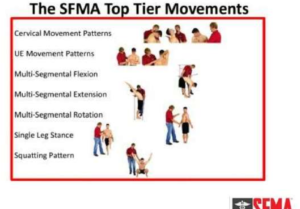Pain= SFMA
SFMA- Selective Functional Movement Assessment
The Basics
The SFMA is designed for patients who have a musculoskeletal complaint (neck pain, back pain, shoulder pain, etc) and want to find the root cause of the problem. There are two parts to a musculoskeletal complaint:
- The site of the pain. This one is very easy for most clinicians. With a good history, exam, special imaging or testing the source of your pain can be found. However, treating the site works may short term, but the problem will often return if the source is not found and addressed. Usually the site of pain is the weakest link in the chain.
- The source or cause of the pain many times is different than the site. However, without finding the source, you may not fully recover or have recurrent exacerbations of your condition. The SFMA is designed to find the cause.
The SFMA is made up of 7 top tier tests, which evaluation your global movement patterns. Each of these tests look at mobility or range of motion, stability and balance which mimic movements from your everyday life.
After the top tier tests, a more complex exam will be conducted to find the root cause or source of your problem. From there a specific Manual Therapy and Rehab Exercise program can be prescribed just for you.
Treating the source of pain is like many pharmaceutical drugs. They mask symptoms but do not address the cause/source of the condition.

More Advanced Info
The SFMA is a comprehensive assessment used to classify movement patterns and direct manual therapy and therapeutic exercise.
It is a system that includes a series of full-body movement tests designed to assess fundamental patterns of moving, such as bending and squatting in those with known musculoskeletal pain. The SFMA creates a more pattern-specific perspective of how each individual patient moves in relationship to their anatomy and medical diagnosis.
When the SFMA is incorporated into the clinician’s assessment, the clinician has the opportunity to identify meaningful impairments that may be seemingly unrelated to the main musculoskeletal complaint, but contributes to the associated disability. This concept, is known as Regional Interdependence, and is the hallmark of the SFMA.
The assessment guides the clinician to the most dysfunctional non-painful movement pattern, which is then assessed in detail. This approach is designed to complement the existing exam and serve as a model to efficiently integrate the concepts of posture, muscle balance and the fundamental patterns of movement into musculoskeletal practice. By addressing the most dysfunctional non-painful pattern, the application of targeted interventions (manual therapy and therapeutic exercise) are not adversely affected by pain.
SFMA offers healthcare professionals a new approach to the treatment of pain and dysfunction. It gives the clinician a movement baseline in order to better direct treatment of manual therapy and functional exercise.
Chris has performed the SFMA since 2014 on thousands of patients, and professional athletes including the PGA Tour, NHL and NFL. The SFMA is a key part in a clinician’s toolbox to get to the root cause of a patient’s problem and to improving one’s performance.


